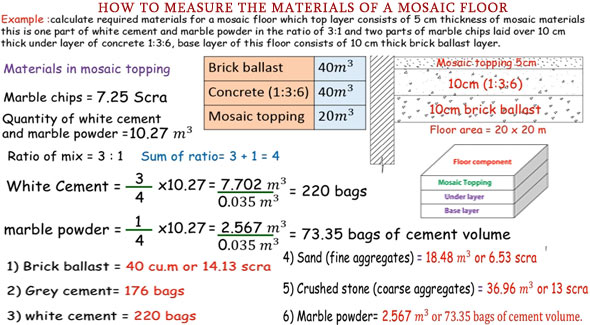How to measure the materials of a mosaic floor
- Concrete Cost Estimator
- Concrete Continuous Footing
- Landscape Bidding and Estimating
- Construction Cost Estimating
- Concrete and steel cost estimation
- Construction Cost Estimate Breakdown
- Construction Estimating Worksheet
- Home Construction Cost Estimate
- Estimate Pricing Sheet
- Sheet for General Contractor
- Construction Cost Estimate
- Labor Materials Cost Estimator
- Masonry Estimating Sheet
- Sheet for Building Contractor
- Construction Schedule Bar chart
- General Cost Estimator Sheet
- General Construction Estimate
- Building and Road Estimating Sheet
- Detailed expense estimates
- Door and Window Takeoff Sheet
- General Construction Cost Estimating Sheet

In this construction video tutorial, S.L. Khan, the renowned engineer, makes brief discussion on how to compute the materials for topping, under layer and base layer of a mosaic floor.
Mosaic floor stands for the top portion of a floor that is developed with mosaic materials. Mosaic materials are formed by mixing stone chips, white cement and marble powder.
To clear your conception, both the problem and solution are given in this video.
Example: Workout the necessary materials toward a mosaic floor which top layer is made of mosaic materials having depth 5 cm. The under layer of the floor is 10 cm and it is constructed with concrete in the ratio of 1:3:6. The sub base of the floor is 10 cm and it is constructed with brick ballast. The total area of the floor is 20 x 20 m.
Now calculate the quantities of the following materials for this mosaic floor :-
Brick Ballast (In sub base), Grey Cement, White Cement, Sand (Fine Aggregates), Crushed Stone (Course Aggregates), Marble Powder, Marble Chips
Initially, you have to make calculation for the following three heads :-
1) Brick ballast in sub base
Total floor area x thickness = 20 x 20 x 0.10 (10 cm = 0.10m) = 40 m3
2) Concrete in under layer (1:3:6)
Total floor area x thickness = 20 x 20 x 0.10 = 40 m3
3) Volume of mosaic topping
Total floor area x thickness = 20 x 20 x 0.05 (5 cm = 0.05 m) = 20 m3
Now, on the basis of the above figure, you have to calculate the quantities of the above mentioned materials. To learn the calculation process, go through the following video tutorial.
Video Source: SL Khan

- Application of concrete calculator
- Roofing Calculator can streamline the roof estimating process
- House construction cost calculator
- Engineering column design excel spreadsheet
- Material Estimating Sheet with Excel
- Materials List and Cost Estimate Worksheet
- Concrete Slab Estimating Calculator Sheet
- Common types of foundations for buildings
- Online calculation of construction materials
- Estimating with Excel for the Small Contractor
- Concrete Beam Design Spreadsheet
- Virtual Construction Management app for construction
- Autodesk’s Project Skyscraper
- Reed Construction’s Reed Insight
- Manage your construction project documentation
- Costimator, the popular cost estimating software
- On Center Software for construction professionals
- Free Construction Estimating Software
- Plumbing Calc Pro
- Cost Estimate Worksheet
- HVAC Piping Quantity Takeoff Worksheet
- Construction Estimating Software Sheet
- Estimate Cost Templates
- Construction Punch List
- Construction cost estimating template consisting estimating basic
- Gantt Chart Template for Excel
- Download Civil Engineering Spreadsheets with Verification
- The Building Advisor Estimating and Budgeting Worksheet
- Spreadsheet for design of concrete bridge
- Construction Estimating Software Free








